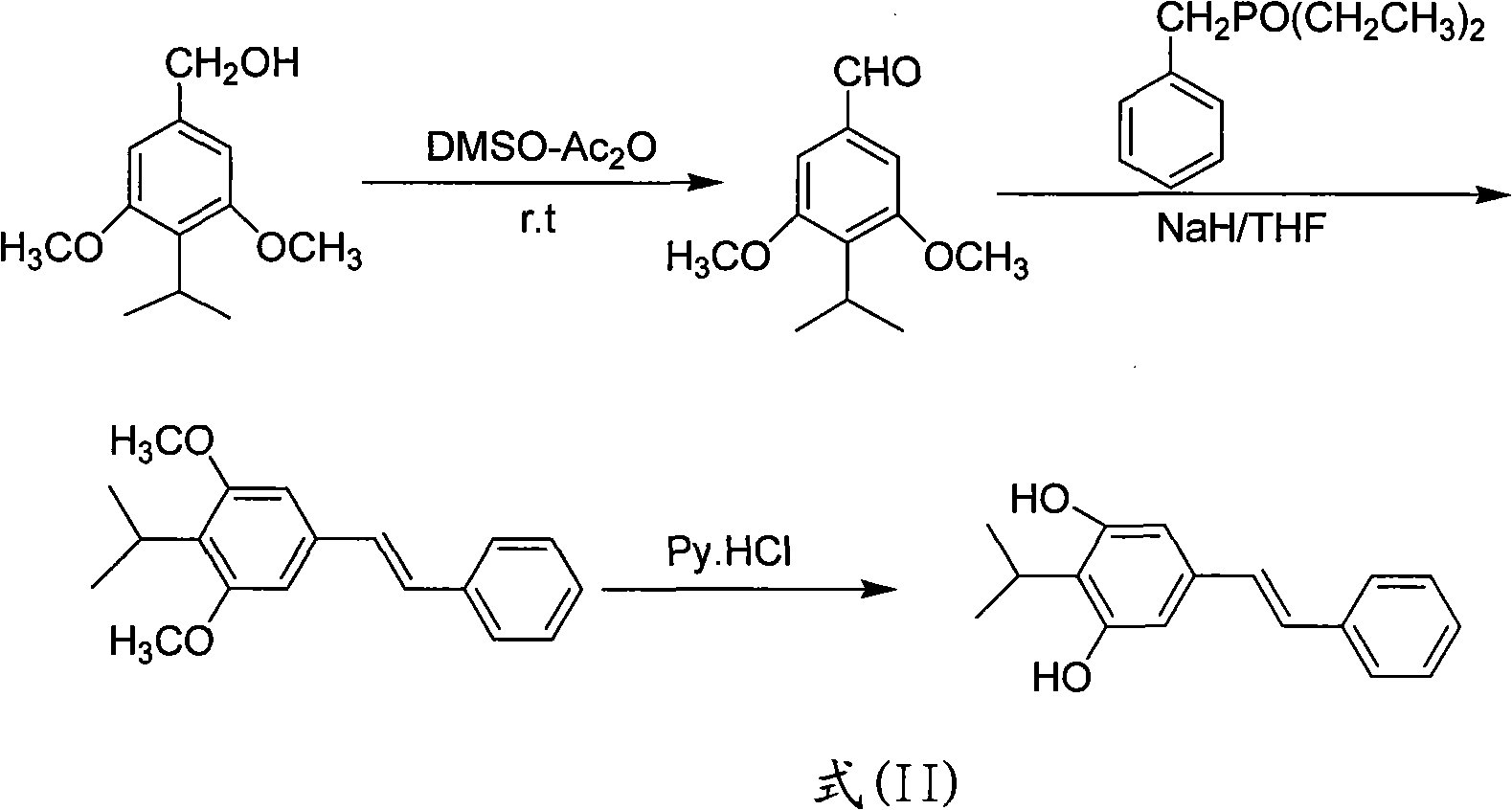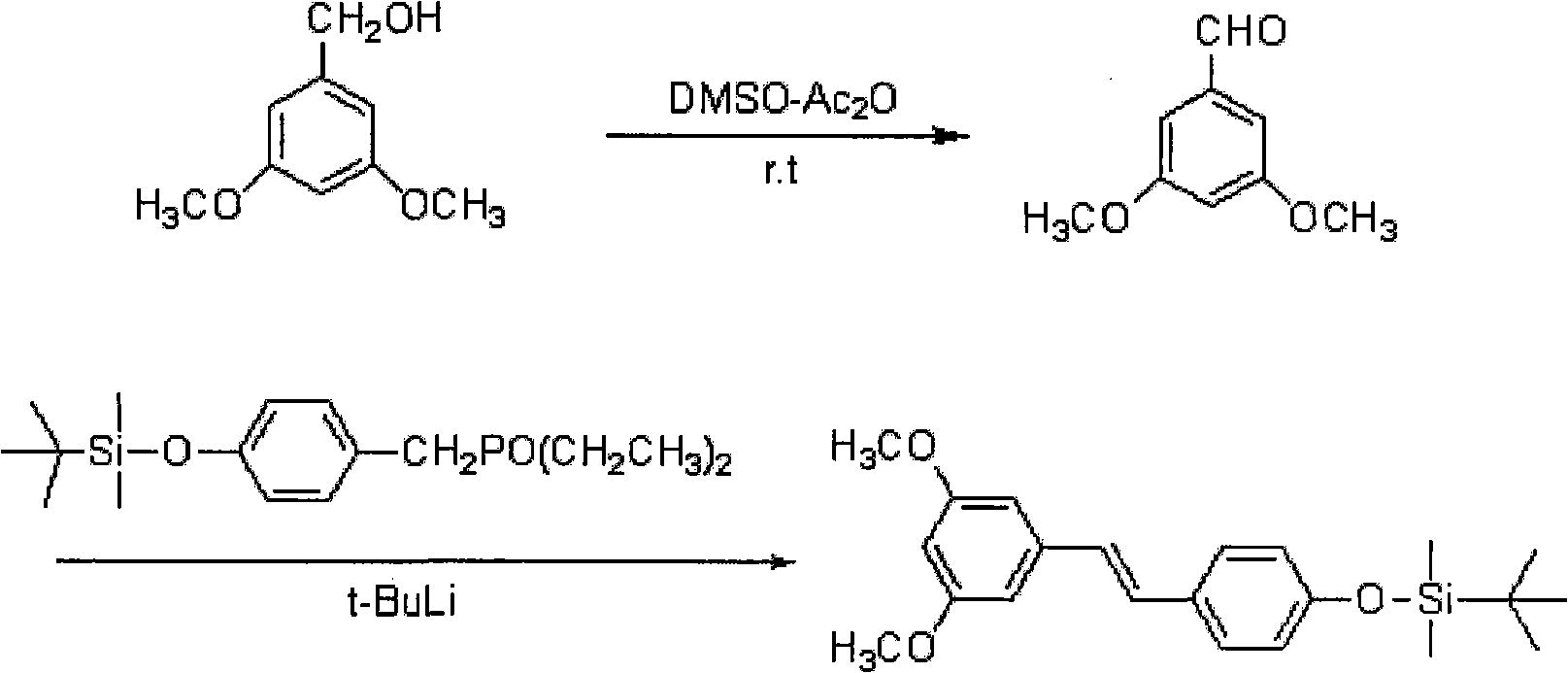Method for synthesizing Stilbene compound by utilizing Pfitzner-moffatt oxidizing reaction
A technology of stilbene compounds and oxidation reaction, which is applied in the field of synthesis of stilbene compounds by Pfitzner-moffatt oxidation reaction, which can solve the problems of high toxicity, environmental damage, and difficulty in industrial production
- Summary
- Abstract
- Description
- Claims
- Application Information
AI Technical Summary
Problems solved by technology
Method used
Image
Examples
Embodiment 1
[0102] Example 1 A method for synthesizing 3,5-dimethoxy-4-isopropylstilbene, namely styrene moder, by Pfitzner-moffatt oxidation reaction
[0103] The reaction scheme of present embodiment is as formula (II):
[0104]
[0105] Its reaction process is a 1 →b 1 → c 1 , the step-by-step reaction is as follows:
[0106]
[0107] Utilize the method of Pfitzner-moffatt oxidation reaction to synthesize phenylene modad to carry out according to the following sequence of steps:
[0108] a 1 .Compound A 1 That is, the preparation of 3,5-dimethoxy-4-isopropylbenzaldehyde:
[0109] Take 10.0 g (47.6 mmol) of 3,5-dimethoxy-4-isopropylbenzyl alcohol, 33 mL DMSO, and 22.5 mL acetic anhydride into a four-necked flask, stir, react at room temperature, and monitor by TLC. After the reaction is completed, add water, extract with ethyl acetate, wash with water, and remove the solvent by rotary evaporation to obtain product A 1 8.72g (41.9mmol). Yield 88%.
[0110] b 1 .Compound...
Embodiment 2
[0119] Example 2 A method for synthesizing 3,5-dimethoxy-4'-hydroxystilbene, namely pterostylbene, by using the Pfitzner-moffatt oxidation method
[0120] The reaction scheme of present embodiment is as formula (III):
[0121]
[0122] Formula (III)
[0123] Its reaction process is a 2 →b 2 → c 2 , the step-by-step reaction is as follows:
[0124]
[0125] This method is carried out according to the following sequence of steps:
[0126] a 2 .Compound A 2 That is, the preparation of 3,5-dimethoxybenzaldehyde:
[0127] Take 10.0 g (59.5 mmol) of 3,5-dimethoxybenzyl alcohol, 50 mL DMSO, and 30 mL acetic anhydride into a four-neck flask, stir, react at room temperature, and monitor by TLC. After the reaction is completed, add water, extract with ethyl acetate, wash with water, and remove the solvent by rotary evaporation to obtain product A 2 8.55 g (51.5 mmol). Yield 86.5%.
[0128] b 2 .Compound B2 is the preparation of 3,5-dimethoxy-4'-tert-butyldimethylsilyl...
Embodiment 3
[0137] Example 3 Synthesis method 1 of the method for synthesizing 3,4',5-trihydroxystilbene, namely resveratrol, by Pfitzner-moffatt oxidation reaction
[0138] The reaction scheme of present embodiment is as formula (IV):
[0139]
[0140] Formula (IV)
[0141] Its reaction process is a 3 →b 3 → c 3 , the step-by-step reaction is as follows:
[0142]
[0143]
[0144] This method is carried out according to the following sequence of steps:
[0145] a3 .Compound A 3 That is, the preparation of 3,5-dimethoxybenzaldehyde
[0146] Take 10.0 g (59.5 mmol) of 3,5-dimethoxybenzyl alcohol, 60 mL of DMSO, and 40 mL of acetic anhydride into a four-necked flask, stir, react at room temperature, and monitor by TLC. After the reaction is completed, add water, extract with ethyl acetate, wash with water, and remove the solvent by rotary evaporation to obtain product A 3 8.87g (53.4mmol). Yield 89.8%.
[0147] b 3 .Compound B3 is 3,4 ', the preparation of 5-trimethoxys...
PUM
 Login to View More
Login to View More Abstract
Description
Claims
Application Information
 Login to View More
Login to View More - R&D
- Intellectual Property
- Life Sciences
- Materials
- Tech Scout
- Unparalleled Data Quality
- Higher Quality Content
- 60% Fewer Hallucinations
Browse by: Latest US Patents, China's latest patents, Technical Efficacy Thesaurus, Application Domain, Technology Topic, Popular Technical Reports.
© 2025 PatSnap. All rights reserved.Legal|Privacy policy|Modern Slavery Act Transparency Statement|Sitemap|About US| Contact US: help@patsnap.com



